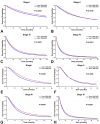Modern Radiation Further Improves Survival in Non-Small Cell Lung Cancer: An Analysis of 288,670 Patients
- PMID: 30662537
- PMCID: PMC6329848
- DOI: 10.7150/jca.26600
Modern Radiation Further Improves Survival in Non-Small Cell Lung Cancer: An Analysis of 288,670 Patients
Abstract
Background: Radiation therapy plays an increasingly important role in the treatment of patients with non-small-cell lung cancer (NSCLC). The purpose of the present study is to assess the survival outcomes of radiotherapy treatment compared to other treatment modalities and to determine the potential role of advanced technologies in radiotherapy on improving survival. Methods: We used cancer incidence and survival data from the Surveillance, Epidemiology, and End Results database linked to U.S. Census data to compare survival outcomes of 288,670 patients with stage I-IV NSCLC treated between 1999 and 2008. The primary endpoint was overall survival. Results: Among the 288,670 patients diagnosed with stage I-IV NSCLC, 92,374 (32%) patients received radiotherapy-almost double the number receiving surgery (51,961, 18%). Compared to other treatment groups and across all stages of NSCLC, patients treated with radiotherapy showed greater median and overall survival than patients without radiation treatment (p < 0.0001). Radiotherapy had effectively improved overall survival regardless of age, gender, and histological categorization. Radiotherapy treatment received during the recent time period 2004 - 2008 is correlated with enhanced survival compared to the earlier time period 1999 - 2003. Conclusion: Radiation therapy was correlated with increased overall survival for all patients with primary NSCLC across stages. Combined surgery and radiotherapy treatment also correlates with improved survival, signaling the value of bimodal or multimodal treatments. Population-based increases in overall survival were seen in the recent time period, suggesting the potential role of advanced radiotherapeutic technologies in enhancing survival outcomes for lung cancer patients.
Keywords: non-small cell lung cancer (NSCLC); overall survival; radiotherapy; treatments.
Conflict of interest statement
Competing Interests: The authors have declared that no competing interest exists.
Figures





References
-
- Siegel RL, Miller KD, Jemal A. Cancer statistics, 2018. CA Cancer J Clin. 2018;68:7–30. - PubMed
-
- Tyldesley S, Boyd C, Schulze K, Walker H, Mackillop WJ. Estimating the need for radiotherapy for lung cancer: an evidence-based, epidemiologic approach. Int J Radiat Oncol Biol Phys. 2001;49:973–85. - PubMed
-
- Herbst RS, Morgensztern D, Boshoff C. The biology and management of non-small cell lung cancer. Nature. 2018;553:446–54. - PubMed
-
- Van Houtte P, Rocmans P, Smets P, Goffin JC, Lustman-Marechal J, Vanderhoeft P. et al. Postoperative radiation therapy in lung caner: a controlled trial after resection of curative design. Int J Radiat Oncol Biol Phys. 1980;6:983–6. - PubMed
-
- Phlips P, Rocmans P, Vanderhoeft P, Van Houtte P. Postoperative radiotherapy after pneumonectomy: impact of modern treatment facilities. Int J Radiat Oncol Biol Phys. 1993;27:525–9. - PubMed
Grants and funding
LinkOut - more resources
Full Text Sources

